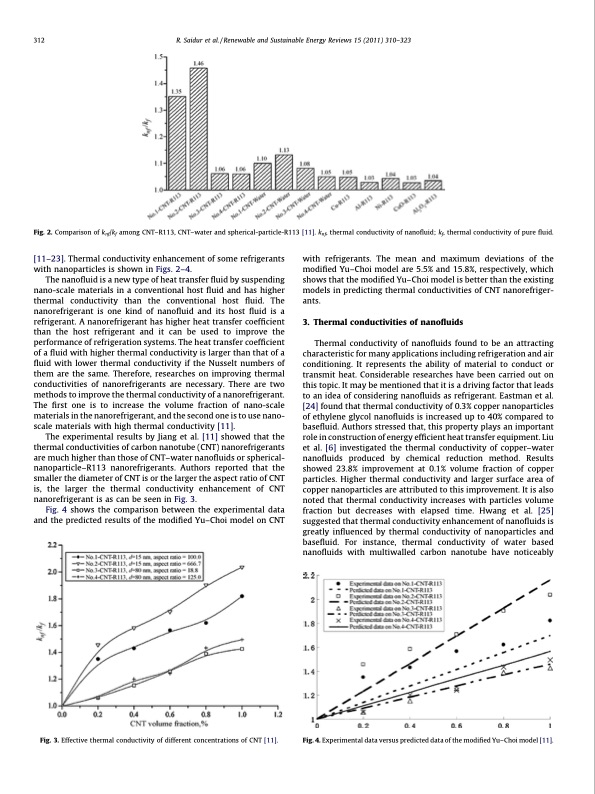
PDF Publication Title:
Text from PDF Page: 003
$[(Fig._2)TDF]GI312 R. Saidur et al. / Renewable and Sustainable Energy Reviews 15 (2011) 310–323 Fig. 2. Comparison of knf/kf among CNT–R113, CNT–water and spherical-particle-R113 [11]. knf, thermal conductivity of nanofluid; kf, thermal conductivity of pure fluid. [11–23]. Thermal conductivity enhancement of some refrigerants with nanoparticles is shown in Figs. 2–4. The nanofluid is a new type of heat transfer fluid by suspending nano-scale materials in a conventional host fluid and has higher thermal conductivity than the conventional host fluid. The nanorefrigerant is one kind of nanofluid and its host fluid is a refrigerant. A nanorefrigerant has higher heat transfer coefficient than the host refrigerant and it can be used to improve the performance of refrigeration systems. The heat transfer coefficient of a fluid with higher thermal conductivity is larger than that of a fluid with lower thermal conductivity if the Nusselt numbers of them are the same. Therefore, researches on improving thermal conductivities of nanorefrigerants are necessary. There are two methods to improve the thermal conductivity of a nanorefrigerant. The first one is to increase the volume fraction of nano-scale materials in the nanorefrigerant, and the second one is to use nano- scale materials with high thermal conductivity [11]. The experimental results by Jiang et al. [11] showed that the thermal conductivities of carbon nanotube (CNT) nanorefrigerants are much higher than those of CNT–water nanofluids or spherical- nanoparticle–R113 nanorefrigerants. Authors reported that the smaller the diameter of CNT is or the larger the aspect ratio of CNT is, the larger the thermal conductivity enhancement of CNT nanorefrigerant is as can be seen in Fig. 3. Fig. 4 shows the comparison between the experimental data (]GIF$DT)3_.giF[and the predicted results of the modified Yu–Choi model on CNT with refrigerants. The mean and maximum deviations of the modified Yu–Choi model are 5.5% and 15.8%, respectively, which shows that the modified Yu–Choi model is better than the existing models in predicting thermal conductivities of CNT nanorefriger- ants. 3. Thermal conductivities of nanofluids Thermal conductivity of nanofluids found to be an attracting characteristic for many applications including refrigeration and air conditioning. It represents the ability of material to conduct or transmit heat. Considerable researches have been carried out on this topic. It may be mentioned that it is a driving factor that leads to an idea of considering nanofluids as refrigerant. Eastman et al. [24] found that thermal conductivity of 0.3% copper nanoparticles of ethylene glycol nanofluids is increased up to 40% compared to basefluid. Authors stressed that, this property plays an important role in construction of energy efficient heat transfer equipment. Liu et al. [6] investigated the thermal conductivity of copper–water nanofluids produced by chemical reduction method. Results showed 23.8% improvement at 0.1% volume fraction of copper particles. Higher thermal conductivity and larger surface area of copper nanoparticles are attributed to this improvement. It is also noted that thermal conductivity increases with particles volume fraction but decreases with elapsed time. Hwang et al. [25] suggested that thermal conductivity enhancement of nanofluids is greatly influenced by thermal conductivity of nanoparticles and basefluid. For instance, thermal conductivity of water based ([Fig._4)TD$FIG]nanofluids with multiwalled carbon nanotube have noticeably Fig. 3. Effective thermal conductivity of different concentrations of CNT [11]. Fig. 4. Experimental data versus predicted data of the modified Yu–Choi model [11].PDF Image | Renewable and Sustainable Energy Reviews

PDF Search Title:
Renewable and Sustainable Energy ReviewsOriginal File Name Searched:
A_review_on_the_performance_of_nanoparticles_suspended_with_refrigerants_and_lubricating_oils_in_ref.pdfDIY PDF Search: Google It | Yahoo | Bing
NFT (Non Fungible Token): Buy our tech, design, development or system NFT and become part of our tech NFT network... More Info
IT XR Project Redstone NFT Available for Sale: NFT for high tech turbine design with one part 3D printed counter-rotating energy turbine. Be part of the future with this NFT. Can be bought and sold but only one design NFT exists. Royalties go to the developer (Infinity) to keep enhancing design and applications... More Info
Infinity Turbine IT XR Project Redstone Design: NFT for sale... NFT for high tech turbine design with one part 3D printed counter-rotating energy turbine. Includes all rights to this turbine design, including license for Fluid Handling Block I and II for the turbine assembly and housing. The NFT includes the blueprints (cad/cam), revenue streams, and all future development of the IT XR Project Redstone... More Info
Infinity Turbine ROT Radial Outflow Turbine 24 Design and Worldwide Rights: NFT for sale... NFT for the ROT 24 energy turbine. Be part of the future with this NFT. This design can be bought and sold but only one design NFT exists. You may manufacture the unit, or get the revenues from its sale from Infinity Turbine. Royalties go to the developer (Infinity) to keep enhancing design and applications... More Info
Infinity Supercritical CO2 10 Liter Extractor Design and Worldwide Rights: The Infinity Supercritical 10L CO2 extractor is for botanical oil extraction, which is rich in terpenes and can produce shelf ready full spectrum oil. With over 5 years of development, this industry leader mature extractor machine has been sold since 2015 and is part of many profitable businesses. The process can also be used for electrowinning, e-waste recycling, and lithium battery recycling, gold mining electronic wastes, precious metals. CO2 can also be used in a reverse fuel cell with nafion to make a gas-to-liquids fuel, such as methanol, ethanol and butanol or ethylene. Supercritical CO2 has also been used for treating nafion to make it more effective catalyst. This NFT is for the purchase of worldwide rights which includes the design. More Info
NFT (Non Fungible Token): Buy our tech, design, development or system NFT and become part of our tech NFT network... More Info
Infinity Turbine Products: Special for this month, any plans are $10,000 for complete Cad/Cam blueprints. License is for one build. Try before you buy a production license. May pay by Bitcoin or other Crypto. Products Page... More Info
| CONTACT TEL: 608-238-6001 Email: greg@infinityturbine.com | RSS | AMP |